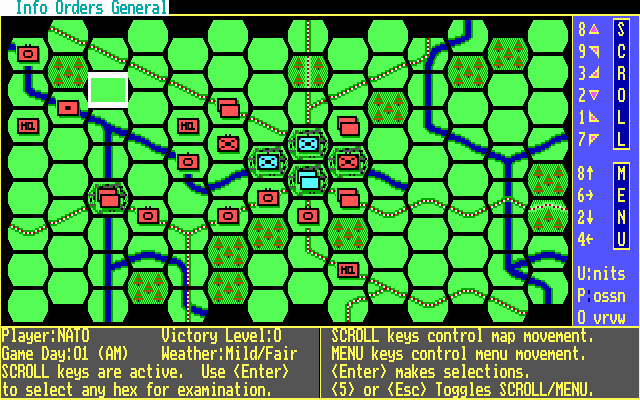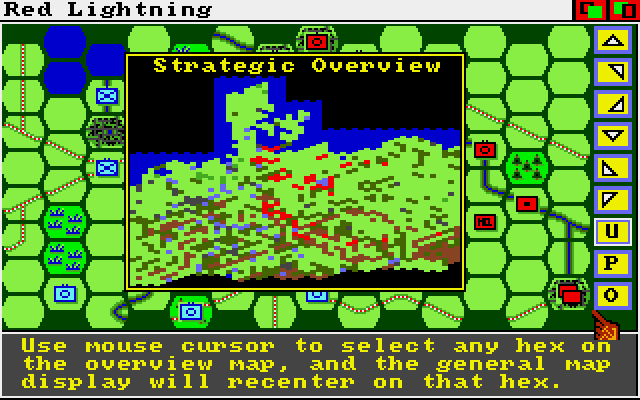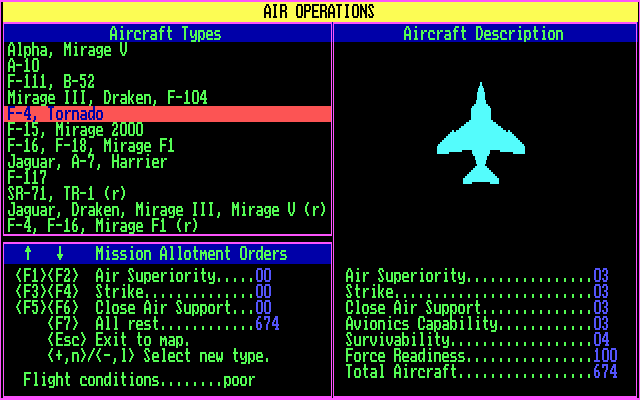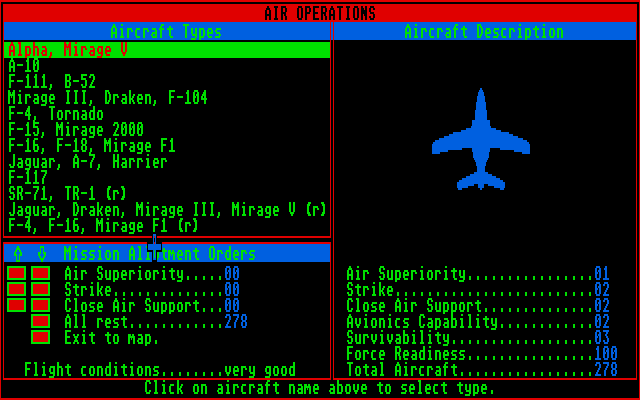Retro Replay Review
Gameplay
Red Lightning delivers a deeply strategic operational wargame experience, pitting the Soviet and NATO forces in a tense, hypothetical World War III scenario set in early 1990s central Europe. Each turn represents a critical window for maneuver, supply, and combat resolution. Players must manage not only frontline assaults but also the intricate web of logistics and reinforcements that can tip the balance of the campaign.
(HEY YOU!! We hope you enjoy! We try not to run ads. So basically, this is a very expensive hobby running this site. Please consider joining us for updates, forums, and more. Network w/ us to make some cash or friends while retro gaming, and you can win some free retro games for posting. Okay, carry on 👍)
The game employs a classic hex-based map that spans from the East German plains to the industrial heart of the Ruhr. Units are represented by counters denoting infantry, armor, and support formations, each with variable attack, defense, and mobility stats. Supply lines are the lifeblood of your army: keep your front units within range of depots or risk crippling combat penalties and potentially catastrophic breakthroughs by the enemy.
Commanders on both sides can choose from numerous scenarios, from short “border clash” engagements to sprawling full-campaign clashes that last dozens of turns. The Soviet player revels in bold offensives, aiming to smash through NATO’s forward defenses and seize critical crossroads. Conversely, the NATO commander must orchestrate delaying actions, counterattacks, and timely reinforcements—often relying on air support and artillery to blunt the Red Army’s momentum.
Multiplayer and solo play both shine here. The built-in AI offers a competent opponent, adept at exploiting weak flanks or overextending its forces, while human opponents bring unpredictable strategies that test your adaptability. The game’s turn structure—Move, Combat, and Supply phases—ensures that every decision carries weight, rewarding foresight and punishing hasty advances.
Graphics
Visually, Red Lightning adheres to the traditional aesthetics of early 1990s wargames. The map is functional and clear, featuring subdued colors that distinguish terrain types—woodlands, urban areas, rivers, and open plains. While there are no flashy 3D models or dynamic weather effects, the interface focuses on clarity and precision, ensuring that every hex is easy to read and every unit icon conveys vital information.
Counters are crisp and well-labeled, with NATO and Warsaw Pact units differentiated by color borders and insignia. This makes order-of-battle recognition instantaneous, even in the heat of a multi-pronged offensive. The terrain shading and elevation contours help you identify chokepoints, defensive strongholds, and potential flanking routes at a glance.
Animations are minimal but purposeful: movement paths highlight in real time, and combat resolution pop-ups display casualties, morale shifts, and supply status without bogging down gameplay. The game’s aesthetic is clearly designed for veterans of classic board wargames, favoring function over flash. This retro style enhances immersion for those who relish a pure simulation, though newcomers to the genre may find it austere at first.
Overall, Red Lightning’s graphics serve the game’s operational feel, keeping players focused on grand strategy rather than visual spectacle. The UI menus and tooltips are straightforward, with layered information panels that cater both to novices seeking basic data and experts who want in-depth combat and logistics breakdowns.
Story
Red Lightning does not follow a scripted narrative or character-driven plot; instead, its “story” emerges from the evolving front lines of a hypothetical NATO–Warsaw Pact war. Briefing screens set the stage with historical context and order-of-battle details, immersing players in the tension of early-1990s geopolitics as the Iron Curtain era teeters on collapse.
Each scenario is framed as an operational dossier: intelligence estimates, strategic objectives, and reinforcements schedules. As the Soviet commander, you feel the weight of planning a massive armored thrust through East Germany, racing to capture the Ruhr industrial region before Western reserves can stabilize the front. Meanwhile, the NATO briefing underlines the urgency of halting those armored spearheads with combined arms tactics and rapid redeployments.
The emergent narrative is driven by your successes and setbacks. A daring pincer maneuver that breaks through to the Rhine feels like a cinematic triumph, while a stalled offensive due to overextended supply lines sparks genuine frustration and prompts a rethink of strategy. There’s no single “campaign story arc,” but the ebb and flow of battle creates its own dramatic momentum.
For fans of alternate history and strategic simulation, Red Lightning’s story is its own reward. You craft the narrative through each decision, each lost brigade, and each hard-won town. The open-ended nature means no two playthroughs unfold the same way, offering a sandbox for military planners and history buffs alike.
Overall Experience
Red Lightning stands as a testament to pure operational-level wargaming. Its depth and complexity cater squarely to enthusiasts who relish logistics planning, unit management, and historical “what-if” scenarios. While the learning curve can be steep—especially when balancing supply lines against ambitious offensives—the payoff is an unparalleled feeling of strategic mastery once you grasp the core systems.
The game’s scenario variety and adjustable difficulty levels ensure replayability. Whether you launch a blitzkrieg-style strike as the Soviets or orchestrate a dogged defense as NATO, each campaign feels fresh. Multiplayer matches heighten the tension, with human opponents often executing unorthodox tactics that challenge even the most seasoned general.
Though the visual presentation is rooted in an earlier era of PC gaming, Red Lightning’s focused design philosophy means there’s very little bloat. Menus are efficient, turn times remain reasonable, and the game runs smoothly on modern hardware—or even in a window on modest systems. This streamlined experience lets you devote your attention to the operational puzzle rather than waiting on overly elaborate cutscenes or loading screens.
In sum, Red Lightning is essential for dedicated wargamers seeking a robust, historically flavored simulation of a hypothetical central European conflict. Its blend of strategic depth, scenario flexibility, and emergent storytelling makes for an absorbing experience—one that will keep military strategists and history enthusiasts engaged for dozens of campaigns.
 Retro Replay Retro Replay gaming reviews, news, emulation, geek stuff and more!
Retro Replay Retro Replay gaming reviews, news, emulation, geek stuff and more!









Reviews
There are no reviews yet.